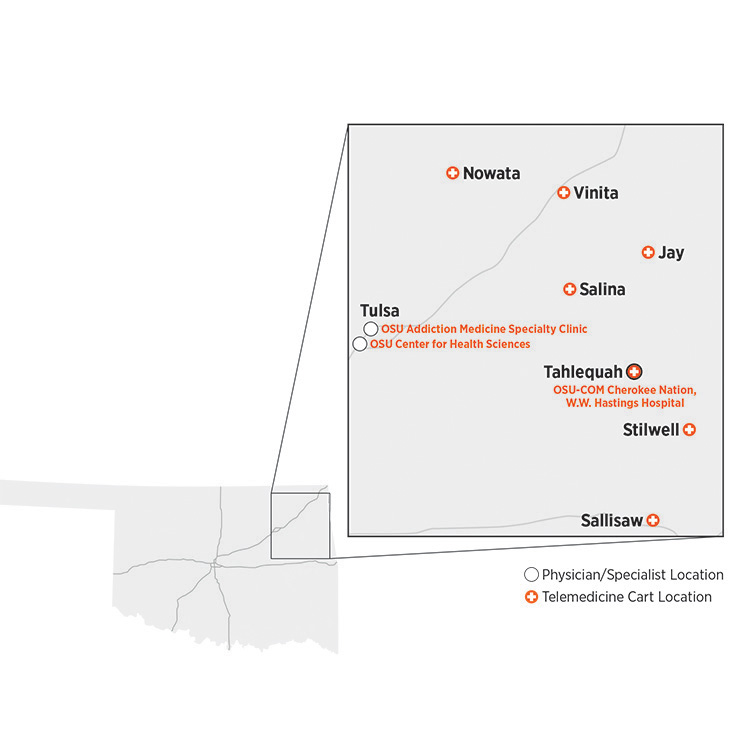
OSU-CHS wins USDA grant to set up telemedicine hubs in northeast Oklahoma
Thursday, May 14, 2020
Living in rural Oklahoma, just seeing a doctor can be a challenge. But thanks to a recent grant from the U.S. Department of Agriculture, more patients in some rural and underserved communities will soon be able to visit with a physician face-to-face even if they are miles apart with the help of ever-advancing technology.
The OSU Center for Health Sciences has been awarded approximately $300,000 from the USDA to purchase telemedicine equipment to provide patient care and clinician training to northeast Oklahoma.
The grant, along with matching funds from OSU-CHS, will subsidize the purchase of telemedicine equipment and infrastructure development.
“This technology will further extend OSU Medicine’s health services to not only meet growing patient demand but also provide training for medical students, residents and physicians throughout northeast Oklahoma,” said Dr. Kayse Shrum, president of OSU Center for Health Sciences and dean of the OSU College of Osteopathic Medicine.
The telemedicine program provides health services between three hub sites — the OSU-CHS campus and the OSU Addiction Medicine Specialty Clinic in Tulsa, and the new OSU College of Osteopathic Medicine at the Cherokee Nation in Tahlequah — and seven clinical sites in the Cherokee Nation, including the W.W. Hastings Hospital in Tahlequah.
The other sites include Cherokee Health Services’ rural clinics in Jay, Nowata, Salina, Sallisaw, Vinita and Stilwell.
Using telecommunication technology, patients living near these seven rural clinical sites will be able to visit with a physician at one of the hub sites via screens and cameras on mobile telemedicine carts that can be utilized throughout the clinic.

“Developing distant learning opportunities helps strengthen our region and fulfills multiple needs for the Cherokee Nation, including expanding access to physicians and medical care to meet patient demand,” said Roger Montgomery, M.D., executive medical director of health services for the Cherokee Nation.
With an aging physician workforce and a growing population in Oklahoma, health care needs continue to increase, resulting in a severe physician shortage, especially in rural areas of the state.
“The Cherokee Nation, under Chief Chuck Hoskin’s leadership, understands the severe physician shortage crisis in rural Oklahoma and shares our vision of populating rural and tribal areas of our state with OSU-trained primary care physicians,” Shrum said.
The goal of the USDA grant and the matching funds is to provide a telemedicine network to train medical students, residents and area physicians to bridge this gap in the physician workforce shortage and provide patient care to meet the growing demand.
“With this equipment, distance is not a factor in providing care or collaborating with our partners. We will be able to help meet the demand for patient care and enhance training for our students and residents,” said William Pettit, D.O., dean of the OSU College of Osteopathic Medicine at the Cherokee Nation, which will welcome its inaugural class this fall.
The grant also aims to curb the effects of the opioid epidemic in northeast Oklahoma. In 2015 and 2016, pharmaceutical companies sent 184 million doses of opioids into the 14 counties of the Cherokee Nation, which would be enough for 153 doses per person over two years.
Through the telemedicine program, patients will be able to receive care from the OSU Addiction Medicine Specialty Clinic, a part of the National Center for Wellness & Recovery. There is a nationwide shortage of addiction medicine physicians, but it is especially felt in rural Oklahoma.
“The lack of available and appropriate training for physicians to treat substance use disorders has created a significant gap in the provision of service,” said Julie Croff, Ph.D., executive director of the National Center for Wellness & Recovery.
“The NCWR is committed to finding innovative solutions, like telemedicine, to treat those in need while also training our health care workforce in this important treatment modality.”
The addiction medicine clinic will use the equipment to provide both preventative and treatment services for opioid use disorder, a pattern that causes serious impairment and distress to one’s life.
The infrastructure provided through the USDA grant will also provide training for physicians and clinicians throughout northeast Oklahoma on proper prescribing for opioids and complementary and alternative pain management methods from OSU’s addiction medicine team.
